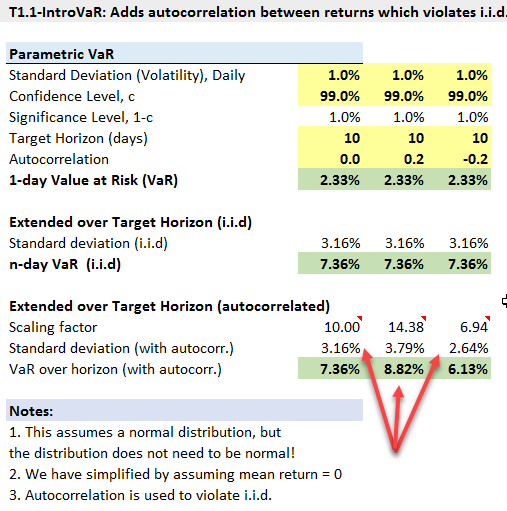emilioalzamora1
Well-Known Member
Hi All,
I just wanted to share an important topic which is unfortunately completely neglected in the GARP curriculum.
Under the assumptions of i.i.d we know that the following properties apply to the scaling of mean and variance (volatility) - I am referring to C. Alexander 'Market Risk Analysis' here:
Given a certain annualizing factor 'A' (let's say A equals 12) we want to convert monthly returns (A = 1) into annual returns (hence, the annualising factor of 12, A = 12):
1. μA >> mean scales proportionately with the annualizing factor A (Mu times A)
2. σ^2A >> variance scales proportionately with the annualizing factor A (sigma squared times A)
3. σ*sqrt(A) >> standard deviation scales disproportionately with the the square root of the annualizing factor A (sigma times the square root of A)
Morningstar has published the following note about 'What’s Wrong with Multiplying by the Square Root of Twelve' talking about the original formula proposed by Tobin (1965) and how to more appropriately scale variance (volatility):
For all of those interested: I did some random manipulation and in line with the theory it reveals that scaling with the 'square root rule' will underestimate standard deviation.
The formula for the variance goes like this. Assume we have calculated the variance over a given time period simply given below as σ^2 (at t:0) on the right-hand side while
on the left-hand side we have σ^2 (the scaled variance at t:1) to be clear about the notation:
σ^2(scaled for 'n' periods) = [ { σ^2 + (1+μ)^2 }^n - (1+μ)^(2*n) ]
If we wish to scale monthly variance to annual variance, 'n' in the above formula is 12 and in the right-hand side of the equation 1+mu is raised to the power of (2*12).
Notice, we can also use 'A', the annualising factor, in the formula above to be in line with C. Alexander.
Hope this is helpful.
I have attached the paper here: https://corporate.morningstar.com/U...ents/MethodologyPapers/SquareRootofTwelve.pdf
I just wanted to share an important topic which is unfortunately completely neglected in the GARP curriculum.
Under the assumptions of i.i.d we know that the following properties apply to the scaling of mean and variance (volatility) - I am referring to C. Alexander 'Market Risk Analysis' here:
Given a certain annualizing factor 'A' (let's say A equals 12) we want to convert monthly returns (A = 1) into annual returns (hence, the annualising factor of 12, A = 12):
1. μA >> mean scales proportionately with the annualizing factor A (Mu times A)
2. σ^2A >> variance scales proportionately with the annualizing factor A (sigma squared times A)
3. σ*sqrt(A) >> standard deviation scales disproportionately with the the square root of the annualizing factor A (sigma times the square root of A)
Morningstar has published the following note about 'What’s Wrong with Multiplying by the Square Root of Twelve' talking about the original formula proposed by Tobin (1965) and how to more appropriately scale variance (volatility):
For all of those interested: I did some random manipulation and in line with the theory it reveals that scaling with the 'square root rule' will underestimate standard deviation.
The formula for the variance goes like this. Assume we have calculated the variance over a given time period simply given below as σ^2 (at t:0) on the right-hand side while
on the left-hand side we have σ^2 (the scaled variance at t:1) to be clear about the notation:
σ^2(scaled for 'n' periods) = [ { σ^2 + (1+μ)^2 }^n - (1+μ)^(2*n) ]
If we wish to scale monthly variance to annual variance, 'n' in the above formula is 12 and in the right-hand side of the equation 1+mu is raised to the power of (2*12).
Notice, we can also use 'A', the annualising factor, in the formula above to be in line with C. Alexander.
Hope this is helpful.
I have attached the paper here: https://corporate.morningstar.com/U...ents/MethodologyPapers/SquareRootofTwelve.pdf
Last edited:

